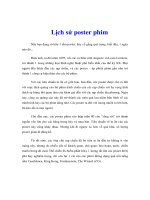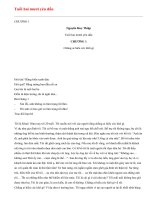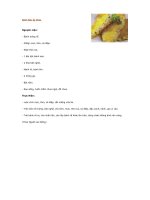POSTER PRESENTATION TIPS docx
Bạn đang xem bản rút gọn của tài liệu. Xem và tải ngay bản đầy đủ của tài liệu tại đây (3.27 MB, 25 trang )
Adapted from a presentation
given by Prof. Angela Gutchess,
Department of Psychology
Created with permission by Jessica
Paquin, Assistant Director for
Academic Internships
Office of the Dean of Arts & Sciences /
Hiatt Career Center
Why Present?
Poster Specifications
What’s Your Story?
Goals of Experiential Learning
Aspects of Effective Poster Presentations
Samples of Posters from Last Year’s (EL)
2
Symposium
Poster presentations are
a great opportunity for
undergraduates to:
Gain experience in presenting your work
in a formal setting
Receive feedback from faculty and peers
Share ideas and learn from other students
Enhance your resume
Usually 1 foam board
No tri-folds
40” x 30 or 32”
White or black
Project Title
• Name
• Year
• Contact Info
32”
40 ”
What did you do?
• Why interesting? Important?
But not ONLY about what you did
• Outcomes? Who was affected?
• Reflection? How were you affected?
• Helpful information/advice to share with others?
• Why would others want to know about this?
When creating your poster, remember Experiential Learning
is:
An Intellectual Challenge
Tackle real-world problems for which there are no answers in the back
of the book.
Challenge your powers of observation, analysis and creative thinking.
Test theories against the concrete; experience, create and prove new
theories.
A Practical Experience
Explore the world of a professional in the field.
Ask yourself, "Is this field the right fit for me?"
Sharpen applications for graduate school and employment by
documenting skills and experience.
Opportunity for Personal Growth
Develop skills to work in groups or independently.
Appreciate differences in learning style, values and world view.
Practice taking informed risks, and learn from mistakes as well as
successes.
htwww.brandeis.edu/experientiallearning/for students/index.html
Begin to make a mental outline
• What journey do you want people to take?
What were the biggest issues?
…Unexpected results?
…Proudest achievements?
…Lessons learned?
What are your next steps?
Readable
Legible
Well-Organized
Succinct
Limited time to convey your message to your
audience
• May have <3 minutes/person
• What are your most important points?
Choose one memorable message
Avoid grammar & punctuation mistakes
Do the topics resonate with the audience?
• Why should they know this?
• The “grandmother” rule: Would she understand
it?
Studies show you only have 11 seconds to grab
and retain the audience’s attention.
Aim for “visually clean and pleasing”
Can they read it from 6-10 feet away?
A poster is not a cut-up essay
• (Again)What are your most important points?
• Large font!! (30+ point)
• High contrast font colors
• Borders or mounting sections of text help
Spatial organization makes the difference
between reaching 95% rather than 5%
of the audience.
Audience shouldn’t have to hunt for main idea/
takeaways
Space in-between sections; Visually neat
A good flow of logic
Impactful, short titles
• Avoid jargon
• Borders or mounting
sections of text help
Don’t overwhelm them, entice them!
• Think of 1-2 sentences to say to
everyone
• What are your most important points?
Your one memorable message?
Keywords and Section headings that
make an impact
Pictures and graphs instead of
paragraphs
Show, don’t tell
• Less (text) is more
• Bullet points
Can you use organization’s handouts?
Photos & figures speak volumes and break
up sections
Use of color (if you can)
• Printing
• Borders/mounting
Personalized Titles
Methods
Outcomes
Research Topic/
Problem
Organization/Lab
Challenges
Successes
Lessons Learned
Highlights of the
Experience
Next Steps… where is
this taking you?
May differ depending on the type of poster
(Science Research vs. others)
Proofread!!
Get feedback from friends or mentors
before printing
• Clear & easy to understand?
• Clean & well designed?
• Memorable message?
Know what you most want to tell people
• 1-2 sentence version; 3 minute version
Last year’s
Experiential
Learning
Symposium
program
Students present their posters during a
poster session on Experiential Learning.
• Colorful
borders
• Clean and
easy to read
• Not too
overwhelming
• Interesting
graphics
• “Grabbing”
Keywords
• Simple
design
• Colorful/
use of
contrasting
colors
• Basic but
important
Sections
(What We
Learned)
• Supporting
graphics
• Newspaper
article
• Artistic borders
• Personalized title
• Quotations
• Colorful
• Impactful sections:
-Personal Reflection
-Goals
-Outcomes
• Professionally printed
• Graphics with title
• Catching title
• Clear sections and
results
• Good use of photos &
graph
• Clear & easy to read
• Sections are bordered
•Professionally
printed
• Clear sections
and results
• Good use of
photos &
graph
• Clear & easy
to read
• Sections are
bordered with
color
• Title encompasses
presentation
•Simple concepts; make
one want to stop and
listen
• Graphics/Arrows
show progression
• Creative section titles:
-Personal Journey
-Corporate Journey
How will you share your summer
experience?
Questions?









